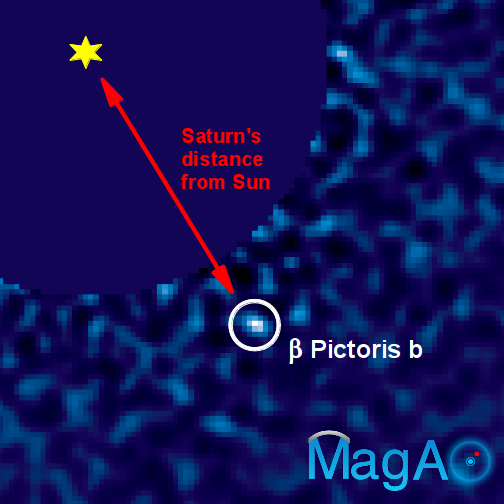There are a number of factors that have pushed extrasolar planet imagers to work in the infrared. The first is that young planets are very hot, so they are brighter in the infrared. In fact, they become very faint at shorter “optical” wavelengths. The second factor is that adaptive optics (AO), the technology we use to image exoplanets, has normally worked better in the infrared. You could say that the stars twinkle less there. But to know as much as we can about exoplanets and their atmospheres, we want to image them at as many wavelengths as we can. So we used MagAO’s VisAO camera to image the extrasolar planet beta Pictoris b with our CCD. This is the first time that has been done from the ground, and shows that we are pushing the capabilities of AO to ever shorter (and more difficult) wavelengths.

Abstract: We present the first ground-based CCD (λ<1μm) image of an extrasolar planet. Using MagAO's VisAO camera we detected the extrasolar giant planet (EGP) β Pictoris b in Y-short (YS, 0.985 μm), at a separation of 0.470±0.010′′ and a contrast of (1.63±0.49)×10−5. This detection has a signal-to-noise ratio of 4.1, with an empirically estimated upper-limit on false alarm probability of 1.0%. We also present new photometry from the NICI instrument on the Gemini-South telescope, in CH4S,1% (1.58 μm), KS (2.18μm), and Kcont (2.27 μm). A thorough analysis of our photometry combined with previous measurements yields an estimated near-IR spectral type of L2.5±1.5, consistent with previous estimates. We estimate log(Lbol/LSun) = −3.86±0.04, which is consistent with prior estimates for β Pic b and with field early-L brown dwarfs. This yields a hot-start mass estimate of 11.9±0.7 MJup for an age of 21±4 Myr, with an upper limit below the deuterium burning mass. Our Lbol based hot-start estimate for temperature is Teff=1643±32 K (not including model dependent uncertainty). Due to the large corresponding model-derived radius of R=1.43±0.02 RJup, this Teff is ∼250 K cooler than would be expected for a field L2.5 brown dwarf. Other young, low-gravity (large radius), ultracool dwarfs and directly-imaged EGPs also have lower effective temperatures than are implied by their spectral types. However, such objects tend to be anomalously red in the near-IR compared to field brown dwarfs. In contrast, β Pic b has near-IR colors more typical of an early-L dwarf despite its lower inferred temperature. For more on our result see: Males, J. R., et al. "Magellan Adaptive Optics first-light observations of the exoplanet β Pic b. I. Direct imaging in the far-red optical with MagAO+VisAO and in the near-IR with NICI" ApJ, 786, 32, 2014 ADS arxiv preprint